Introduction
The world of Web3 Gaming presents a complex situation in 2024. Web3 Gaming is experiencing significant achievements alongside real challenges. Daily active users have surged by more than 300%, reaching 6.58 million. Unfortunately, the Web3 Gaming sector has underperformed in market performance. This sector increased its market capitalization by 60.54%, significantly lagging behind memecoins and AI projects.
In this article, AllSpark Research will focus on discussing the growth of communities in Web3 Gaming and the factors influencing it. The data is based on Research from Footprint Analytics, as featured on the CoinMarketCap (CMC Research) website. This research provides data on user growth, market challenges, and key developments shaping Web3 Gaming.
Overall, the Web3 Gaming sector demonstrated strong growth in 2024 but still lagged behind other crypto sectors. According to Footprint Analytics data, the market capitalization of gaming tokens reached $31.8 billion by the end of the year, reflecting an annual increase of 60.5%. However, in the past two months, gaming tokens have fallen behind other sectors.
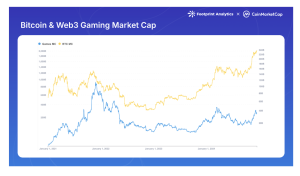
This article will discuss the trends in Web3 Gaming community growth in 2024, the factors influencing the growth of Web3 Gaming communities, the role of investors in driving community growth, the innovation landscape, and the future outlook for Web3 Gaming. Here is a more detailed explanation.
Trends in Web3 Gaming Community Growth in 2024
A. User Growth Statistics and Market Capitalization
Data from Footprint Analytics shows that Web3 Gaming ranks 8th out of the top 10 sectors in market capitalization growth. The Web3 Gaming sector lags far behind leading sectors such as Memecoin (421.1%), AI & Big Data (168.0%), and the Solana Ecosystem (124.1%).
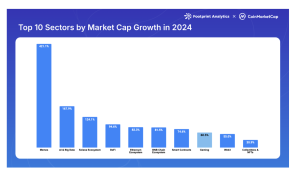 This lag is also reflected in community interest. In the list of most viewed sectors on CoinMarketCap, Web3 Gaming attracts only 6.7% of the total views, placing it 9th among the top 10 sectors.
This lag is also reflected in community interest. In the list of most viewed sectors on CoinMarketCap, Web3 Gaming attracts only 6.7% of the total views, placing it 9th among the top 10 sectors.
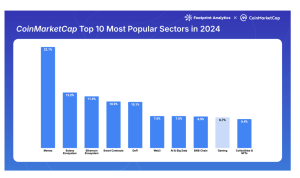
Interestingly, although the Web3 Gaming sector experienced a decline in transactions, trading volume continued to rise. The total trading volume of Web3 Gaming in 2024 reached $5.2 billion, an 18.5% increase compared to 2023. This trend reverses the decline since 2021, although the volume remains far below the peak of the previous cycle. The 2024 figure represents only 6.2% of the 2021 peak ($84.1 billion) and 15.1% of the 2022 volume ($34.5 billion).
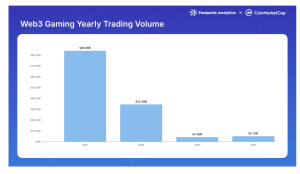
Meanwhile, the total number of transactions in 2024 reached 5.3 billion, a 30.3% decrease compared to the previous year. This figure is comparable to the 2021 transactions of 5.1 billion but continues the downward trend that began in 2022.
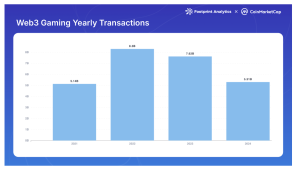
Despite the decline in transactions, several factors influence community growth in Web3 Gaming. One of these factors is sustained engagement. Developers must keep conversations alive through regular updates, events, and active listening.
Efforts to maintain community engagement in Web3 Gaming include hackathons or in-game contests. These activities allow players to build new worlds or compete in challenges, keeping the community active and engaged.
Web3 Gaming also encourages community members to create content, whether through mods, new game modes, or even in-game assets. These activities can foster higher engagement and long-term sustainability. This approach leverages the creativity and passion of the community, which can often lead to unexpected innovations.
Another factor influencing the growth of the Web3 Gaming community is the popularity of NFTs (Non-Fungible Tokens). NFTs represent digital assets such as videos, music, art, and in-game items. The increasing popularity of NFTs has a significant impact on the Web3 Gaming community.
Additionally, the use of blockchain technology allows game developers to create fair and transparent reward systems. Applications with engaging and innovative gameplay are also factors that influence the growth of the Web3 Gaming community.
B. Analysis of Active User Growth and the Role of Community
Daily Active Users (DAU) experienced significant growth throughout 2024, increasing from 1.6 million in January to 6.6 million in December. This reflects a 308.6% increase over the year. This growth surpasses the previous cycle’s peak of 1.8 million DAU in November 2021.
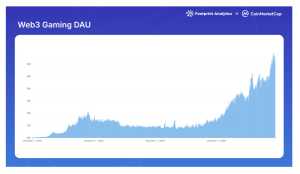
Although these figures may include some bot activity, the significant increase still indicates an extraordinary recovery from the post-2021 decline. Bot activity in Web3 games can be detected by analyzing suspicious player behavior, such as the number of battles played per player and the amount of time spent playing. Bots can play more battles per day than regular players and may spend more time playing games. This is why data-based analysis can be used to identify suspicious player behavior, such as bots, in Web3 games.
Bots are actually also designed to protect the community. Bots can be designed to identify and mitigate malicious actors, such as sybil attacks, within Web3 communities and applications. Proof of exposure is a tool that can be used to combat the rise in bot activity in Web3 games.
Based on this, the community plays a role in driving the adoption of Web3 Gaming, even though bot activity affects the data. A strong community can help expand adoption by supporting projects through active discussions, organic promotion, and participation in development. Communities can also ensure transparency and authenticity of the data used in decision-making, thereby minimizing the impact of bot activity on the data.
Factors Influencing the Growth of Web3 Gaming Communities
A. Ecosystem and Technological Innovation
The Web3 gaming landscape has experienced significant changes in the dominance of chains based on various metrics in 2024. This is evident from the prominent leaders in trading volume, transactions, and user engagement.
BNB Chain continues to lead in trading volume with $1.2 billion (market share of 23.1%), followed by Ethereum with $915.4 million (17.6%). Blast and Ronin have also managed to secure significant market shares of 9.2% and 9.0%, respectively.
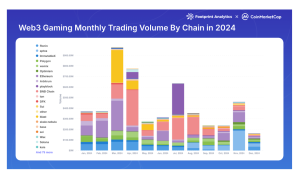
On the other hand, although the total industry transactions have decreased by 30.3%, some chains have shown strong performance. WAX leads with 1.8 billion transactions (33.6% of the total). Aptos emerged as a major player with 616.2 million transactions (11.6%), driven by the Telegram “tap-to-earn” game called Tapos, which generated 540.3 million transactions in August alone. Ronin and opBNB maintained stable transaction volumes with 321.2 million and 317.9 million transactions, respectively.
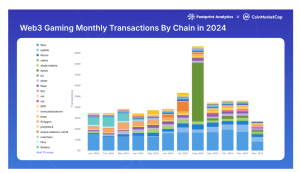
The advancement of Layer 2 has had a significant impact on Web3 Gaming. Ethereum Layer 2 and Layer 3 networks, including Immutable zkEVM, as well as gaming chains based on Avalanche, Oasys, SKALE, Arbitrum Orbit, and other high-throughput blockchains such as Solana, Sui, and Aptos, have affected Web3 Gaming.
Lower gas fees and faster transactions have made it easier and more affordable to purchase items, mint NFTs, and trade in-game assets. This has encouraged more players to join and accelerated the adoption of blockchain-based games. A major milestone in reducing gas fees was achieved through Ethereum’s “Dencun” upgrade (also known as “Proto-Danksharding” or “EIP-4844”) in March 2024, which significantly lowered fees for the L2 network.
On the other hand, incentive programs such as ARB Gaming Catalyst have played a role in attracting developers and users. The ARB Gaming Catalyst program has successfully attracted developers and users with financial, technical, and promotional incentives. This support has driven innovation, increased technological adoption, and strengthened ARB’s position in the blockchain-based gaming industry.
B.The Role of NFT Games in Enhancing Community Engagement
NFT (Non-Fungible Token) is closely linked to Web3 gaming, especially in adding value to elements such as digital ownership, in-game economy, and virtual asset trading. NFT games are a key driver in Web3 Gaming communities. The success of this ecosystem requires the development of high-quality games, clear regulations, and sustainable success stories to build trust and attract the community.
Economic elements like NFTs and tokenomics attract players by offering digital ownership and financial incentives. A good token system creates long-term engagement, encouraging players to continue participating and supporting the growth of Web3 game communities.
There are successful NFT game case studies that have managed to develop an active community, such as Illuvium. This is a decentralized role-playing game (RPG) supported by blockchain technology and NFTs, released in 2021.
The game allows users to search for items and creatures (Illuvials) in the form of NFTs, which can be used for activities such as fighting and trading. Illuvium combines Illuvial NFTs that represent battle items, skins, collectibles, emotes, and much more. According to data from Play to Earn, in 2022, there were more than 7,000 active players in this Illuvium RPG game. Around 1,000-1,500 people played Illuvium daily.
C. The Influence of Social Platforms on Communities
Telegram and social platforms support the Web3 Gaming ecosystem. Telegram has emerged as a strong catalyst for Web3 gaming adoption, accounting for 20.9% of new Web3 game launches. Telegram’s success stems from its massive user base, simple app experience, and its ability to bypass traditional app store restrictions.
The impact of Telegram peaked in Q3 2024, with 11 games surpassing 10 million monthly active users (MAU). Specifically, TON successfully converted this massive user base into on-chain participants, creating a spillover effect in the Web3 gaming sector, memecoins, and DeFi. This success has driven many blockchain networks outside of TON to compete for traffic from Telegram, such as Aptos, Sui, Core, and others, launching their own Telegram-based initiatives.

The integration of social platforms like Telegram facilitates user onboarding into the Web3 Gaming world. This is achieved by providing direct access to a large user base already familiar with the app. Telegram successfully converted its users into on-chain participants, accelerating the adoption of blockchain technology in gaming, memecoins, and DeFi. These factors help users, thereby influencing the growth of Web3 Gaming Communities.
D. Challenges Faced in Community Development
One of the challenges in community development in the Web3 Gaming sector is the decline in the number of games with more than 100 monthly active users. The number of games with more than 100 monthly active users (MAU) decreased from 586 in June 2022 to 522 by the end of 2024. As of November 2024, 161 games (4.5% of the total) have more than 10,000 MAU, with 96 games (2.7% of the total) exceeding 100,000 MAU.
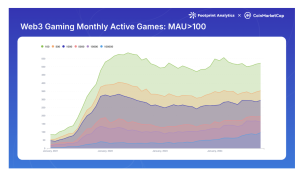
This decline is driven by the intense competition between Web3 Gaming and traditional games, as well as the “play-to-earn” model. Web3 Gaming combines blockchain technology with gameplay to create a new way of enjoying the virtual world. Web3 Gaming competes with traditional games by offering players the ability to own in-game assets, earn real rewards, and form game economies.
Additionally, Web3 Gaming struggles to maintain user engagement within the blockchain ecosystem. Many Web3 games lack lasting appeal, and some prioritize tokenomics over gameplay. Players may also need multiple wallets to access different games, which can be a barrier to widespread adoption. Furthermore, some early Web3 Gaming projects focused on incentives rather than creating great games first.
The Role of Investors in Driving Community Growth
A. Funding Trends and Key Investors
An analysis of the funding raised ($909.4 million from 220 events), focusing on early-stage funding and the investors involved. Sony Group’s involvement signals a major push into blockchain gaming, both through investment and infrastructure development. While supporting a $10 million Series D funding round for double jump.tokyo Inc., Sony also announced Soneium. This is a Layer 2 network aimed at bridging Web3 innovations with consumer applications in the gaming and entertainment sectors.
The role of major investors like Animoca Brands in supporting Web3 game projects. Animoca Brands maintains its leadership position with 38 investments, a 192.3% increase compared to 2023. Additionally, Animoca Brands contributed to 17.3% of all funding events in 2024.
Animoca Brands invests in Web3 projects, partners with other companies, and develops its own blockchain games. Animoca Brands is an investor in Yuga Labs, Axie Infinity, Polygon, and Consensys. Investors in Web3 games help fund the development of blockchain-based games. They also help shape the future of the industry by assessing the risks and potential of new projects.
B. New Projects and Investment Strategies
The launch of new projects in Web3 Gaming is further transforming the industry landscape by offering decentralized gaming experiences and play-to-earn opportunities. The integration of NFTs and blockchain technology brings players more than just entertainment, providing them with digital ownership and access to a growing new economic ecosystem. The Web3 Gaming community is becoming increasingly engaged, transforming from consumers to active participants in the digital ecosystem.
Investment in multi-chain infrastructure and development tools is crucial for supporting the growth of Web3 Gaming. This infrastructure enables integration across blockchain platforms, while advanced development tools simplify the creation of innovative games. Focusing on these two areas accelerates the development of the Web3 Gaming ecosystem, opening new opportunities for creativity and community expansion.
Landscape of Innovation in the Web3 Gaming Community
A. Cross-Platform Trends and Collaboration with Traditional Gaming Companies
Companies like Square Enix are developing blockchain-based games. Square Enix strengthens its presence in blockchain through strategic investments and partnerships. In addition to investing in gaming platforms Elixir Games and HyperPlay, the company announced plans to bring the game Symbiogenesis to HyperPlay. This demonstrates its commitment to developing and supporting infrastructure in the blockchain gaming space.
In addition to infrastructure support, collaboration is also necessary to create an inclusive ecosystem. Web3 games and traditional games collaborate to create new and innovative games. This collaboration can help Web3 games gain mainstream popularity and reach a wider community.
This collaboration is important because it can provide access to resources that can be utilized by Web3 gaming companies. Collaboration can also lead to innovation or new ways of creating games and experiences. Additionally, collaboration can help Web3 games attract a broader community.
The collaboration between Web3 gaming and traditional games is realized by creating games, integrating assets, and utilizing influencer marketing. The benefits of collaboration between Web3 gaming and traditional games include increased player engagement because players can have more ownership over the assets in their games. Another benefit is better transparency, as Web3 games are decentralized, meaning all transactions and interactions are transparent and secure.
B.Integration of Artificial Intelligence in Web3 Games
AI has impacted game development, user experience enhancement, and in-game economies. AI has revolutionized interactions within games and content creation. Game studios leverage AI to create more advanced non-player characters (NPCs) that can adapt to player behavior and generate personalized missions based on individual player histories and preferences. This personalization increases player engagement by making the gameplay experience more relevant and individual.
On the development side, AI has significantly streamlined the creation process. Developers use AI tools to automatically generate game environments and assets, substantially reducing production time and costs. This democratization of game development enables small teams to create high-quality games that can compete with large studios.
AI can support the Web3 gaming community by enhancing player experiences through personalization and intelligent NPCs. By analyzing player data, AI suggests content, items, or challenges based on their preferences, which prolongs player engagement and retention. Furthermore, AI creates smarter and more adaptive NPCs, providing a more dynamic and immersive gameplay experience.
On the other hand, AI strengthens security and fairness in games by detecting suspicious activities and managing virtual economies. This technology maintains the integrity of the game, ensuring a fair and safe experience for all players, and helps the Web3 community grow in a healthy manner.
The Future Outlook: Web3 Gaming in 2025
A. Predictions for the Development of the Web3 Gaming Community
An approach involving Social Platform Integration is considered the most promising route to achieving mainstream relevance. The remarkable success of Telegram-based games demonstrates the power of meeting users where they already are. The use of platforms like Line and TikTok is expected to follow suit. This strategy could offer a solution to user acquisition challenges in this sector by leveraging established social networks instead of building a community from scratch.
Meanwhile, AI plays a crucial role in maintaining user engagement in Web3 gaming by providing a more personalized experience. By analyzing player preferences, AI can recommend suitable games and create more responsive NPCs, making gameplay increasingly engaging and unpredictable.
AI optimizes the gaming experience within the community by creating worlds and levels that continuously change in response to player decisions. It also helps manage virtual economies, such as the pricing and demand for in-game items, making gameplay feel more realistic and dynamic.
In the future, Web3 Gaming, traditional games, AI, and blockchain will be more interconnected. Web3 Gaming uses blockchain to give players ownership of digital assets and rewards in the form of cryptocurrency. Traditional games can integrate this technology, allowing players to own in-game items and creating a more transparent ecosystem. Meanwhile, AI enhances the gaming experience. This interconnectedness will open up new opportunities for monetization and collaboration, pushing the gaming industry towards a more inclusive and innovative future for the community.
B. Challenges and Opportunities
The resilience of the Web3 Gaming sector depends on its ability to adapt to regulatory constraints while continuing to push the boundaries of innovation. Web3 Gaming projects like Minotaurus demonstrate opportunities for growth within a regulatory-compliant framework.
By adopting transparency, investing in compliance tools, and collaborating with regulatory authorities, Web3 Gaming can successfully overcome these obstacles. Ultimately, it is important to focus on community participation and prioritize security when creating a sustainable future for Web3 Gaming. This approach can withstand regulatory pressures and even benefit from them.
Based on this, Web3 Gaming should focus on sustainability and the gaming experience rather than financial profit. Web3 Gaming is built on blockchain technology and designed to create a new gaming experience. Web3 Gaming prioritizes player experience, community engagement, and sustainable economic models.
This is crucial because Web3 Gaming is built around quality gameplay that keeps players engaged. Additionally, Web3 Gaming creates a thriving ecosystem by building a strong community. It also establishes a balanced and sustainable economy that supports long-term success.
Conclusion
The Web3 gaming community is rapidly growing by utilizing blockchain technology, allowing players to own digital assets within the game. The play-to-earn (P2E) model and the use of NFTs add economic value, making the gaming experience more interactive.
With more developers integrating DeFi and the metaverse, its growth potential is immense. The secure and transparent blockchain technology, combined with the enthusiasm of the community, makes Web3 gaming an important part of the future digital economy.
The main challenge in Web3 Gaming is the limited adoption of blockchain technology, both among players and developers. Although blockchain offers transparency and digital ownership, many still struggle to understand its benefits. In addition, many Web3 Gaming projects struggle to build loyal and engaged communities, as the focus is sometimes more on speculation and tokenomics than on delivering a quality gaming experience.
For investors, the challenge lies in evaluating sustainable projects amid the lack of regulation and clear industry standards. Developers need to create games that are not only profitable but also fun and sustainable. Meanwhile, investors should be more selective and focus on projects with strong foundations, rather than just chasing short-term profits.
Optimism for the future of Web3 games is increasing, thanks to blockchain technology, which enables players to own in-game assets in the form of NFTs that can be traded or used across other ecosystems. This provides a more personal and decentralized gaming experience, opening new opportunities for players and developers.
The integration of Web3 games with other digital ecosystems, such as AI, DeFi, and the metaverse, expands the potential of games as centers of the digital economy. Players can interact with various blockchain platforms, earn profits, and develop their assets globally. This makes Web3 gaming an important part of the future digital world. #16

